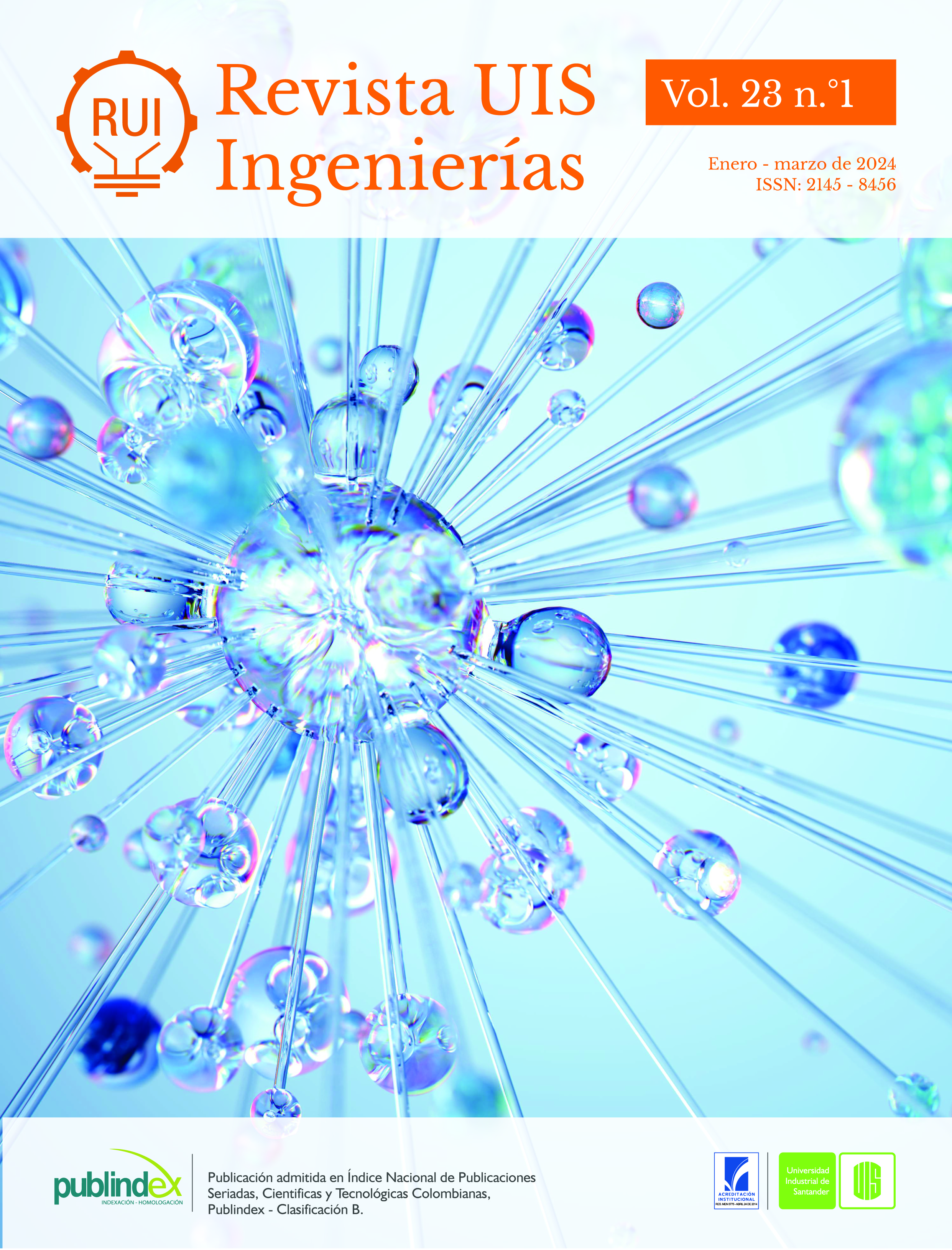Artículos
Uso potencial de las Teorias de Potencia basadas en el enfoque de Fryze para evaluar contribución a la distorsión de forma de onda
Publicado 2024-01-31
Palabras clave
- teorías de potencia,
- asignación de responsabilidades,
- calidad de potencia,
- perturbaciones
Cómo citar
Garzón , C., Blanco , A. M. ., Pavas , A. ., & Meyer , J. . (2024). Uso potencial de las Teorias de Potencia basadas en el enfoque de Fryze para evaluar contribución a la distorsión de forma de onda. Revista UIS Ingenierías, 23(1), 25–38. https://doi.org/10.18273/revuin.v23n1-2024003
Derechos de autor 2024 Revista UIS Ingenierías

Esta obra está bajo una licencia internacional Creative Commons Atribución-SinDerivadas 4.0.
Resumen
Este artículo explora el potencial de algunas teorías de potencia notables derivadas del enfoque de Fryze para evaluar las contribuciones a la distorsión de formas de onda. El análisis se limita a un sistema simplificado compuesto por una carga y una fuente de voltaje conectadas por un punto de acople común. Finalmente, se proponen algunas claves para evaluar dos tipos de sistemas: redes fuertes (sistemas de distribución tradicionales) y redes débiles (microrredes aisladas).
Descargas
Los datos de descargas todavía no están disponibles.
Referencias
- IEEE, “IEEE Recommended Practice and Requirements for Harmonic Control in Electric Power Systems,” IEEE Std 519-2014 (Revision of IEEE Std 519-1992), pp. 1–29, 2014, doi: https://doi.org/10.1109/IEEESTD.2014.6826459
- IEC, “Part 3-6: Limits - Assessment of emission limits for the connection of distorting installations to MV, HV and EHV power systems,” Electromagnetic compatibility (EMC) - IEC TR Std. 61000-3-6, pp. 1–29, 2008. [Online]. Available: https://webstore.iec.ch/publication/4155
- A. Spelko, B. Blazic, I. Papič, M. Pourarab, J. Meyer, X. Xu, and S. Z. Djokic, “Cigre/cired jwg c4.42: Overview of common methods for assessment of harmonic contribution from customer installation,” in 2017 IEEE Manchester PowerTech, pp. pp. 1-6 , 2017, doi: https://doi.org/10.1109/PTC.2017.7981195
- T. Pfajfar and I. Papič, “Harmonic emission level estimation based on measurements at the point of evaluation,” in 2011 IEEE Power and Energy Society General Meeting, pp. 1–5, 2011, doi: https://doi.org/10.1109/PES.2011.6039642
- C. Garzón, A. Pavas, “Review of responsibilities assignment methods for harmonic emission,” in 2019 IEEE Milan PowerTech, pp. 1–6, 2019, doi: https://doi.org/10.1109/PTC.2019.8810742
- R. L. A. E. Emanuel. A. Testa, “Power definitions for circuits with nonlinear and unbalanced loads — the ieee standard 1459-2010,” in 2012 IEEE Power and Energy Society General Meeting, pp. 1–6, 2012, doi: https://doi.org/10.1109/PESGM.2012.6345330
- S. Fryze, “Effective reactive and apparent powers in circuits with nonsinusoidal waveforms,” Electrotehn Zeitshrift, vol. 53, pp. 596– 99, 1932.
- F. Buchhokz, “Understanding the correct power concept of active and reactive power,” Selbsverlag, Munchen, 1950.
- IEEE, “Ieee standard definitions for the measurement of electric power quantities under sinusoidal, nonsinusoidal, balanced, or unbalanced conditions,” IEEE Std 1459-2010 (Revision of IEEE Std 1459-2000), pp. 1–50, March 2010, doi: https://doi.org/10.1109/IEEESTD.2010.5439063
- L. S. Czarnecki, “What is wrong with the budeanu concept of reactive and distortion power and why it should be abandoned,” IEEE Transactions on Instrumentation and Measurement, pp. 834–837, 1987, doi: https://doi.org/10.1109/TIM.1987.6312797
- A. Pavas, “Study of responsibilities assignment methods in power quality (summa cum laude),” Ph.D. dissertation, Universidad Nacional de Colombia, Facultad de Ingeniería, 2012.
- M. Depenbrock, “The FBD method, a generally applicable tool for analyzing power relations,” IEEE Transaction on Power Systems, pp. 381 – 387, 1993, doi: https://doi.org/10.1109/59.260849
- A. Pavas, V. Staudt, H. Torres, “Method of disturbances interaction: Novel approach to assess responsibilities for steady state power quality disturbances among customers,” 14th International Conference on Harmonics and Quality of Power (ICHQP), 2010, doi: https://doi.org/10.1109/ICHQP.2010.5625493
- P. M. P. Tenti, “A time-domain approach to power terms definitions under non-sinusoidal conditions,” in 6th Int. Workshop on Power Definitions and Measurement under NonSinwwidal Conditions, Milan, Italy, 2003.
- P. M. P. Tenti, H. K. M. Paredes, “Conservative power theory, sequence components and accountability in smart grids,” 2010 International School on Nonsinusoidal Currents and Compensation, pp. 37–45, 2010, doi: https://doi.org/10.1109/ISNCC.2010.5524473
- L. S. Czarnecki, “Orthogonal decomposition of the currents in a 3-phase nonlinear asymmetrical circuit with a nonsinusoidal voltage source,” in IEEE Transactions on Instrumentation and Measurement, pp. 30–34, 1988.
- L. S. Czarnecki, “Currents’ physical components (CPC) concept: A fundamental of power theory,” 2008 International School on Nonsinusoidal Currents and Compensation, pp. 1–11, 2008, doi: https://doi.org/10.1109/ISNCC.2008.4627483
- C. Garzón, A. Pavas, “Laplacian eigenvector centrality as tool for assessing causality in power quality,” 2017 IEEE Manchester PowerTech, pp. 1–6, 2017, doi: https://doi.org/10.1109/PTC.2017.7981261
- A. Pavas, V. Staudt, and H. Torres, “Statistical analysis of power quality disturbances propagation by means of the method of disturbances interaction,” Conference on Innovative Smart Grids Technologies - Europe (ISGT-EU), 2012, doi: https://doi.org/10.1109/ISGTEurope.2012.6465817
- IEEE, “IEEE Standard Definitions for the Measurement of Electric Power Quantities Under Sinusoidal, Nonsinusoidal, Balanced, or Unbalanced Conditions,” IEEE Std 1459-2010 (Revision of IEEE Std 1459-2000), pp. 1–50, 2010, doi: https://doi.org/10.1109/IEEESTD.2010.5439063
- S. Yanchenko, J. Meyer, “Harmonic emission of household devices in presence of typical voltage distortions,” 2015 IEEE Eindhoven PowerTech, pp. 1–6, 2015, doi: https://doi.org/10.1109/PTC.2015.7232518
- P. Penfield, R. Spence, S. Duinker, “A generalized form of tellegen’s theorem,” IEEE Transactions on Circuit Theory, vol. 17, no. 3, pp. 302-305, 1970, doi: https://doi.org/10.1109/TCT.1970.1083145
- S. Kannan, A. M. Blanco, C. Garzón, A. Pavas, and J. Meyer, “Harmonic impedance characteristics in an islanded microgrid and its impact on voltage and current harmonics,” 2021 IEEE Madrid PowerTech, pp. 1–6, 2021, doi: https://doi.org/10.1109/PowerTech46648.2021.9494905

